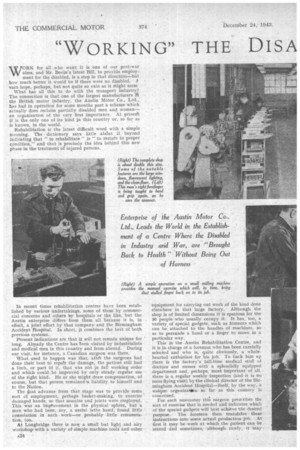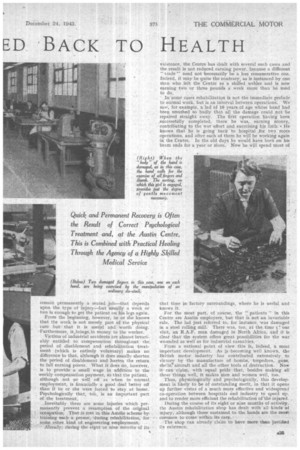"WORKING" THE DISA ED BACK TO HEALTH
Page 26

Page 27

If you've noticed an error in this article please click here to report it so we can fix it.
Enterprise of the Austin Motor Co., Ltd., Leads the World in the Establishment of a Centre Where the Disabled in Industry and War, are "Brought Back to Health" Without Being Out of Harness
Quick and Permanent Recovery is Often the Result of Correct Psychological Treatment and, at the Austin Centre, This is Combined with Practical Healing Through the Agency of a Highly. Skilled
Medical Service
WORK for all who want it is one of our post-war aims, and Mr. Bevin's latest Bill, to panicle employment for the disabled, is a step in that direction—but how much better it would be if there were no disabled. A vain hope, perhaps, but not quite so vain as it might seem What has all this to do with the transport industry? The connection is that one of the largest manufacturers RI the British motor industry, the Austin Motor Co., Ltd., has had in operation for some months past a scheme which actually does reclaim partially disabled men and women— an organization of the very first importance. At presenk it is the only one of its kind in this country or, so far as
is known, in the world. • ., Rehabilitation is the latest difficult word with a simple meaning. The • dictionary says little abOut it beyond indicating that " to rehabilitate " is " to restate to proper condition," and that is precisely the idea behind this new phase in the treatment of injured persons.
In recent times rehabilitation centres have been established by various undertakings, some of them by commercial concerns and others by hospitals or the like, -but the Austin enterprise differs from them all because it is, in. effect, a joint effort by that companyand the Birmingham Accident Hospital. In short, it combines the best of both previous systems.
Present indications are that it will not remain unique for " long. Already the Centre has been visited by industrialists and medical men in this country and from abroad. During our visit, for instance, a Canadian surgeon was there.
What used to happen was that, after the surgeons had done their best to repair the damage; the patient still had a limb, or part of it, that was not. in full working order and which could be improved by only steady regular use of the right kind. He or she might draw compensation, of course, but that person remained a liability to himself and to the Nation.
The Oist advance from that stage was to provide some sort Of employment, perhaps basket-making, to exercise ' damaged hands, so that muscles and joints were employed. This waS an improvement in the physical 'sphere, but a man iiirho had been, ,say, a useful lathe hand, found little consolation in such work—or probably little remuneration, too.
At Longbridge there is now: a small but light and airy workshop with a variety of simple machine tools and other A24 • equipment for carrying out work of the kind done elsewhere in that large factory. Although the shop is of limited dimensions it is spacious for the 30 people-who usually occupy it. It has, too, a variety. of special gadgets, such as fitments which can be attached to the handles of machines, so as to persuade a hand or a finger to move in a particular way.
This is the Austin Rehabilitation Centre, and it is in charge of a foreman who has been carefully selected and who is, quite obviously, a wholehearted enthusiast for his job. To back him up there is the factory's full-time medical staff of doctors and nurses with a splendidly equipped department and, perhaps, most important of all, there is a regular weekly inspection (and it is no mere flying visit) by the clinical director of the Birmingham Accident Hospital—itself, by the way, a unique organization so far as this country is concerned.
For. each newcomer this surgeon prescribes the sort of exercise that is needed and indicates which of the special gadgets will best achieve the desired. purpose. The foreman then translates these instructions into some actual production job. At. first it may be work at which the patient can be seated and sometimes, although rarely, it may
remain permanently a seated job—that depends upon the type of lnjury—but usually a week or two is enough to get the patient on his legs again. From the beginning, however, be or she knows that the work is not merely part of the physiCal cure but that it is useful and worth doing: 'Furthermore, it,,bringsin money to the worker.
Victims of industrial accidents are almost invari-. ably entitled to compensation throughout the. period of disablement and rehabilitation treatment (which is entirely voluntary) makes no difference to that, although it does usually shorten the period of disablement and hasten the return to full earning power. • What it does do, however, is to provide a small wage in addition to the weekly compensation payment, So that the patient, although not so Well off as when in mOrrnal employment, is financially a good deal better off than if he or she Were forced to stay. at horne. . Psychologically that, to, is an important part of the treatment. .
Inevitably there are some injuries which permanently prevent a resumption of the original Occupation. That is met in this Att.stin scheme by training such a person, 'duringrehabilitation, for some. other kind ot, engineering employment.
'Already; during the Eight-or nine months of its •
existence, the Centre has dealt with several such cases and the result is not reduced earning power, because a different " trade " need not ecessarily be a less remunerative one. Indeed, it may be quite the contrary, as is instanced by one man who left the Centre as a skilled welder arid is now earning two or three pounds a week more than he used to do.
In somd cases rehabilitatio.n is not the immediate prelude to normal work, but is an interval between operations. 'We' saw, for example, a lad of 16 years-of age whose hand had been smashed so badly that all the damage could not be repaired straight away. The first operation having been .successfully completed, therehe was, earning trrioney, contributing to the war effort and exercising his limb,
knows that he is going back to hospital for two more operations, and after each of them he will' heworking again in the Centre, In the old days he would have, been on his beam ends for a year or More. Now he will spend most of that time in factory surroundings, where he is useful and knows it.
For the most part of course, the ". patients " in this Centre are Austin employees, but that is not an invariable rule. The lad just referred to, for instance, -was damaged in a steel rolling mill. There was, too, at the time c !'our visit, an R.A.F. man damaged in North Africa, and it is clear that' the system offers great possibilities for the war wounded as well as for industrial casualties.
From a national point of vieW, this is, indeed, a most important development. As is -becomim, well known, the British motor industry has contributed, extensively_ -to victory by -the manufacture of bombs, torpedoes, guns, shells,6aircraft and all the other tools of destruction. Now it can claim, with equal pride that, besides Making all these things well, it makes men and women well, too.
Thus, physiologically and psychologically, -this development is likely to be Of outstanding merit, in that it opens up further vistaa of a much more effective and widespread co-operation between hospitals nd industry to speed up, and to render more efficient the rehabilitation of theinjured.
During the course of its eight or nine months of activity, the Austin rehabilitation shop has dealt with all kinds of injury, although those sustained to the hands are the rrio.st common to come within its carp: . 'The. shop can already claim to have more than justified its existence.




















































